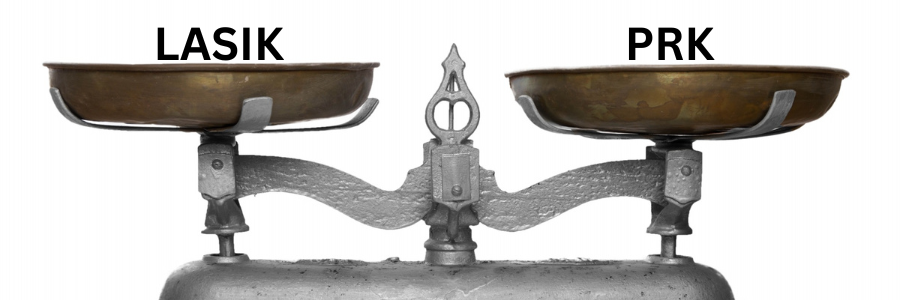Laser eye surgery has transformed the way we treat vision issues, offering patients long-term solutions for refractive errors such as myopia, hyperopia, and astigmatism. Among the most popular procedures for vision correction are LASIK (Laser-Assisted In Situ Keratomileusis) and PRK (Photorefractive Keratectomy). Both techniques involve reshaping the cornea using laser technology, but their approaches and recovery timelines differ significantly. Understanding these differences can help patients make informed decisions about which procedure is best suited for their individual needs.
What is LASIK?
LASIK is a well-known laser vision correction surgery, often favored for its minimal downtime and fast recovery. In this procedure, a thin flap is created on the cornea using either a microkeratome blade or a femtosecond laser. This flap is then lifted, and the underlying corneal tissue is reshaped with an excimer laser to correct the patient’s refractive error. Afterward, the flap is repositioned and allowed to heal naturally.
Benefits of LASIK
One of the primary reasons LASIK has gained widespread popularity is the quick visual recovery it offers. Most patients experience improved vision within 24 to 48 hours, with many returning to normal activities, including work, in just a few days. Additionally, the procedure is virtually painless, with minimal discomfort during recovery.
LASIK is an excellent option for individuals with mild to moderate refractive errors, and its long-term success rates are impressive. The precision of the femtosecond laser ensures high accuracy, reducing the risk of complications such as irregular astigmatism.
Considerations and Risks
While LASIK offers significant benefits, it may not be the best choice for everyone. Those with thin corneas, dry eye syndrome, or high refractive errors may not be suitable candidates. Some patients also experience temporary side effects like short term dry eyes. In rare cases, complications can arise from the corneal flap, which may affect healing and visual outcomes.

What is PRK?
PRK is a precursor to LASIK and was one of the first laser eye surgeries to gain FDA approval. Unlike LASIK, PRK does not involve creating a corneal flap. Instead, the surgeon removes the outer layer of the cornea, known as the epithelium, to expose the underlying tissue. An excimer laser is then used to reshape the cornea, similar to LASIK. The epithelium regenerates naturally over the course of a few days following surgery.
Benefits of PRK
PRK offers a key advantage for individuals with thinner corneas, as it does not require the creation of a flap. This makes it a more suitable option for patients who are not ideal candidates for LASIK. Additionally, since there is no flap involved, there is a reduced risk of flap-related complications, such as displacement or wrinkles.
PRK is also an excellent option for those who are more physically active, as the absence of a corneal flap eliminates the risk of injury or trauma to the eye following surgery. This makes PRK a popular choice for athletes and individuals in professions that involve physical exertion.
Considerations and Risks
While PRK offers several benefits, its recovery timeline is longer compared to LASIK. Since the epithelium must regenerate, patients may experience discomfort, blurry vision, and sensitivity to light for a few days post-surgery. Full visual recovery can take several weeks, and some patients may not achieve optimal results until three to six months after the procedure.
Although rare, PRK carries risks similar to LASIK, including temporary dry eyes. However, because the epithelium is removed, the initial healing phase can be more uncomfortable, requiring patients to use medicated eye drops and protective contact lenses for several days.
Key Differences Between LASIK and PRK
Understanding the key differences between LASIK and PRK is crucial for making an informed decision. While both surgeries aim to correct refractive errors by reshaping the cornea, their approaches, recovery times, and long-term effects differ.
| Aspect | LASIK | PRK |
|---|---|---|
| Corneal Flap | Yes, a thin flap is created | No, the outer layer of the cornea is removed |
| Recovery Time | Fast, with improved vision in 24-48 hours | Slower, full recovery can take several weeks |
| Suitability | Ideal for patients with thicker corneas | Suitable for patients with thinner corneas |
| Post-Surgery Discomfort | Minimal discomfort | More discomfort during the initial healing phase |
| Risk of Complications | Low, but flap-related risks exist | No flap-related risks, but higher short-term discomfort |
Which Procedure is Right for You?
The choice between LASIK and PRK depends on various factors, including your corneal thickness, lifestyle, and overall eye health. Individuals with thicker corneas and mild to moderate refractive errors often find LASIK to be the more convenient option due to its faster recovery. On the other hand, patients with thinner corneas, those engaged in physically demanding activities, or individuals at risk for dry eyes may benefit more from PRK.
It is essential to undergo a thorough consultation with a qualified ophthalmologist who can assess your eyes’ unique anatomy and recommend the best procedure based on your specific needs. Both LASIK and PRK are safe and effective surgeries that have transformed the lives of millions of people worldwide, offering clearer vision and a life less dependent on corrective eyewear.
Post-Operative Care and Long-Term Outcomes
Regardless of the procedure you choose, post-operative care plays a critical role in ensuring successful outcomes. Patients will need to use prescribed eye drops to prevent infection and reduce inflammation. It is also essential to avoid rubbing the eyes and protect them from bright lights during the healing process. Regular follow-up appointments with your eye surgeon will help monitor your recovery and address any concerns that may arise.
Both LASIK and PRK offer long-term vision correction with high satisfaction rates. However, it is important to note that while laser eye surgery can significantly reduce dependence on glasses or contact lenses, it may not entirely eliminate the need for corrective eyewear, particularly as patients age and develop conditions such as presbyopia.
Categories




